44 Search Results for presume competence
March 20, 2014
by Carole Zangari -
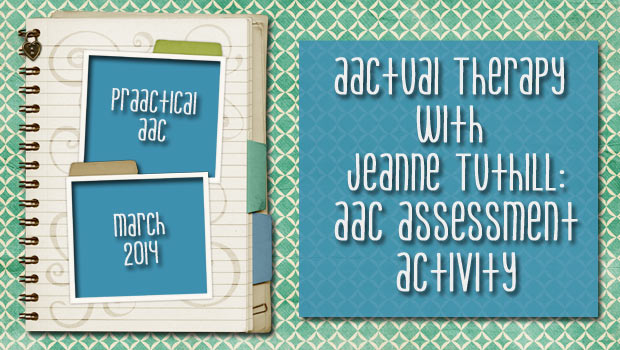
We’re so excited to introduce a new AACtual therapist, Jeanne Tuthill. Jeanne has been an SLP for over 15 years and has specialized in AAC for the past 6 years. As an AT specialist for the Collaborative Center for Assistive Technology and Training (CCATT) in Northampton, Massachusetts, Jeanne evaluates and provides consultation services for K-12 students in schools throughout Western Massachusetts. In addition, she provides workshops and professional development training in that region. Since 2012, Jeanne has served as an adjunct faculty member for the Assistive Technology Graduate Program at Simmons College. She has also presented at a number of regional and national conferences. You can see Jeanne here with her long-time student Lauren Suprenant, who is using a Step-by-Step Communicator, to share information about how she communicates with others (introduction strategy). Jeanne shares a little bit about her work and then discusses an activity that is used in their AAC... [Read More...]
March 10, 2014
by Robin Parker -
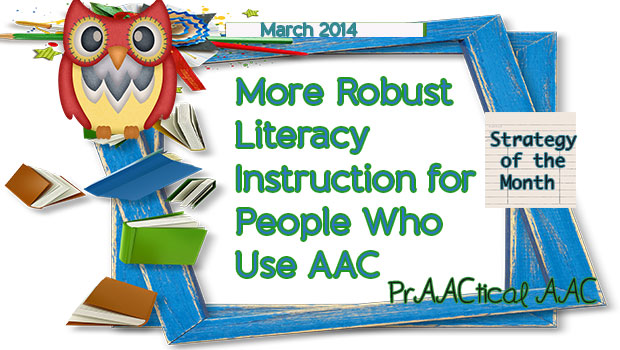
We love learning about AAC and literacy from resources that have a ‘presume competence’ philosophy, that provide research support, and that include specific teaching guidelines. With these ideas in mind, we love the Literacy Curriculum found on the Literacy Instruction Website by Janice Light and David McNaughton at Penn State. There are specific guidelines for providing literacy instruction to individuals with severe communication impairments. There is a specific curriculum to tell you what skills to teach, reasons for teaching those skills, how to teach the skills, and videotaped examples of teaching the curriculum. There is listed research support that you can use to understand the rationales for the skills you are teaching as well as provide evidence-based information about why you are choosing the approach. This post is intended to provide an introduction to the Literacy Curriculum. For comprehensive information go to the Literacy Instruction Website by Janice Light and David McNaughton.... [Read More...]
December 14, 2013
by Robin Parker -
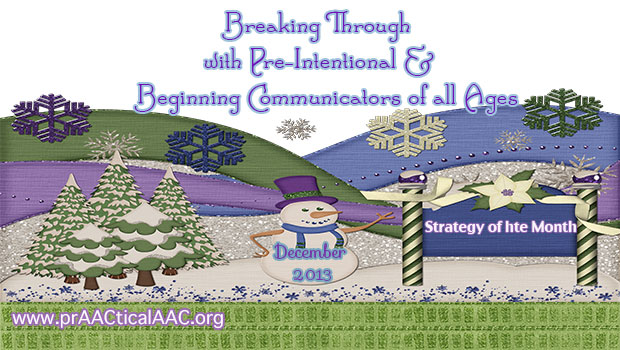
We are thinking a lot about emerging-intentional and beginning communicators. Even within these categories it seems there are sub-categories. We have a subset of learners who seem difficult to engage. They do not often respond to communication initiations by others. They can be content looking at small items or through self-stimulatory behaviors. These learners can get “communication” overlooked in class, in intervention, and at home because they can be quiet and subdued a lot of the time. They can be prompted through activities and events without difficulty but they often do not get to be communication initiators. And without a lot of practice initiating, it is hard to improve. You may hear or think these things about the learner: She does not like anything He is in his “own world” He does not care what he gets It seems like she can not hear She does not look at what... [Read More...]
November 9, 2013
by Robin Parker -
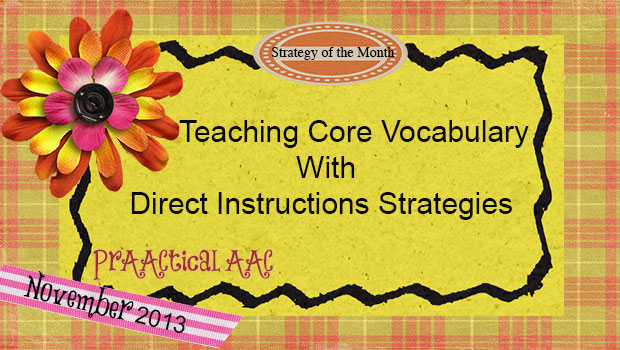
Vocabulary instruction involves a systematic TEACHING process. Core vocabulary words are harder to represent with pictures but still need to be taught with direct instruction. Many of the strategies and activities are part of general vocabulary teaching. Decide your core word vocabulary to teach and begin with strategies, steps, and fun activities. Teaching Strategies Teach in Meaningful Language Experiences– Create activities about the words but also about the communication behind the words. Develop activities that are meaningful to the learners. Provide Active Participation Opportunities- Develop many, many (many) opportunities for the learners to use the vocabulary as an expressive communication tool as well as for receptive language. Have the learner interact with the core word vocabulary rather than just listen to explanations. Give the vocabulary communicative power for the learner. Use Aided Language Input– Model AAC style. Use Focused Language Stimulation – Highlight new words and use them repetitively. We like... [Read More...]
October 10, 2013
by Carole Zangari -
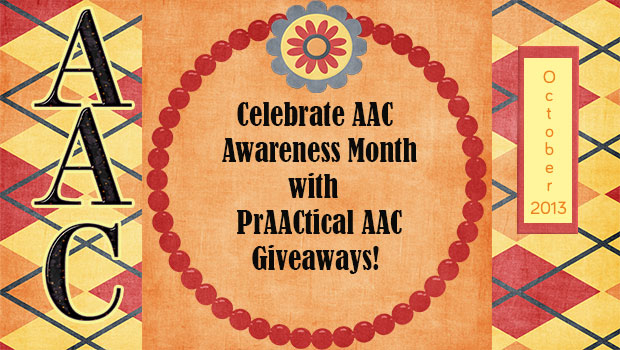
It’s been an exciting beginning to AAC Awareness Month! There were many lucky winners in Celebration #1! The winners for PrAACtical AAC Celebration are # 1 are Susan J., Linda K., Tracey Z., Lauren E., Jeanne T., Krista C., Alison A., Robin S., Laura K., Cassandra S., Becky K., Claire G., Susan G., Melissa S., Felicia W., Alecia W., Diane F., Danette P., Doug M., Shannon L., Jeannie M., & Barbara F. Congratulations to the winners! Please join us in giving virtual round of applause to these generous companies: Ablenet, Inc Alexicom BeeVisual Choice Works Dynavox Hump Software Mozzaz News-2-You Paul H. Brookes Publishing Company Safe N Sound Mobile Silver Lining Multimedia Smarty Ears Speak For Yourself SpeechPathology.com TapSpeak TherapyBox/TBoxApps Look for a new PrAACtical AAC Celebration on Friday (tomorrow).
September 21, 2013
by Carole Zangari -
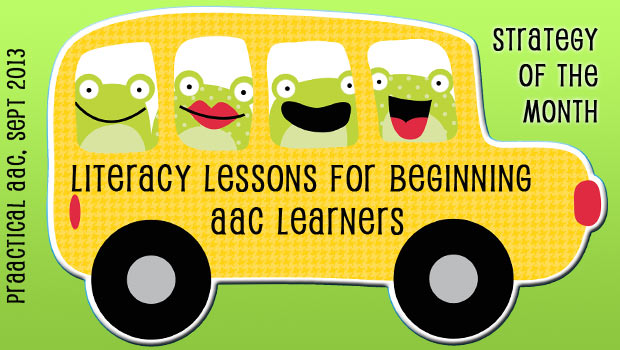
Like some of you, we are often met with skepticism when we encourage teams to work on literacy skills with individuals who are still learning the very basics of communication. Recently, we had the opportunity to begin this journey anew, and model a literacy lesson for kindergartners who have no formal communication system, are not answering yes/no questions, and do not consistently select preferred items when offered choices. Why work on literacy with students who are not routinely expressing their basic preferences? Because the longer we wait, the longer it will take to get there. Because it offers wonderful opportunities to build communication, too. Because when other people see us teaching reading and writing, it changes their perception of the student in a positive way. Because they will enjoy it. Because there are mandates for us to address the general education curriculum. Because if we set the bar high and... [Read More...]
September 20, 2013
by Robin Parker -

We have said this before, we say it now, and we will say it again because time and time again we are surprised in great ways. Aided Language Input Talk About Relevant Topics Talk About Age-Appropriate Topics Use Language Facilitation Techniques And….Listen to the Message, Be a Communication Partner, Have Fun!
August 10, 2013
by Robin Parker -
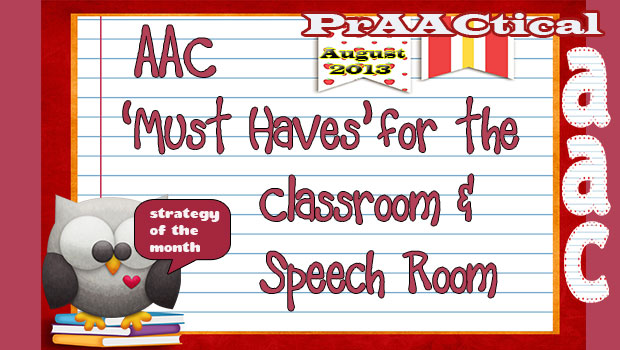
As we were getting ready for back to school and thinking about ‘must haves’, it quickly became apparent that it is not so easy to narrow it down. And the ‘must haves’ would definitely vary depending upon type of class, students, and even school. Based on a wide variety of differences, we organized a wide variety of choices to explore (we apologize in advance if we got carried away but…). Choose what you need, bookmark what you may need later and let us know your ‘must haves’ for a classroom and speech room AAC collaborative approach. We will create an ongoing list. Get Started Before School Starts Do these 10 Things to Get Started with AAC if you are new to an AAC student or classroom Provide AAC Support in the Classroom. Support teachers and educators with tips from Jane Farrall, & learn about AAC in the Classroom by Joan... [Read More...]
May 18, 2013
by Carole Zangari -
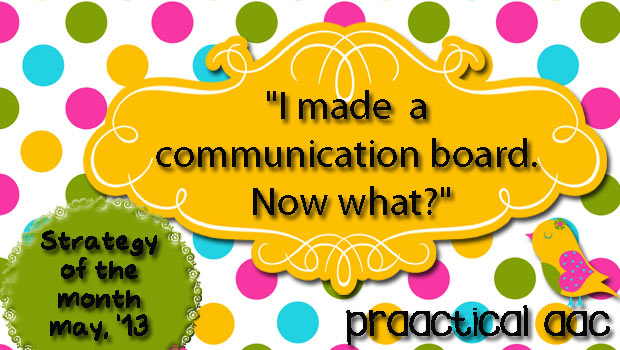
Earlier this month, we shared some ideas for making communication boards using color coding and also for creating boards geared to different communicative purposes. Making the communication board according to some basic principles is a good thing, of course, and it takes a decent amount of thought and planning. Even more important, though, is developing an intervention plan so that the augmentative communicator learns how to use the board effectively. Here are some of our thoughts on how to teach someone to use a new communication board. Model It We’ve talked about aided language input so many times that I’m almost embarrassed to mention it. Almost. The truth is, it is a ‘must do’ strategy when we’re first introducing a communication board, book, SGD, or AAC app. Incidental learning is important for just about all of the people with whom we work. It is never the only strategy we use,... [Read More...]
May 11, 2013
by Robin Parker -
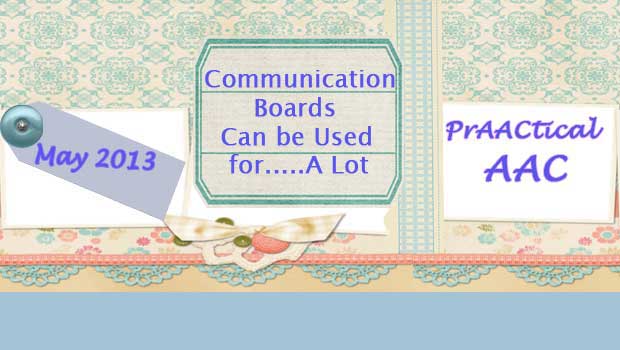
When we think of AAC and communication boards or displays, we often think of comprehensive core and fringe words. We think of a board that will represent the most possible communication functions, vocabulary, and generative language. However, there are many other ways to create and use communication boards. There are many other ways because there are many reasons we communicate and sometimes it is best to create a communication board that focuses on a specific communication need. AAC is not one thing but a system of communication supports, and for most AAC users, there should be a multitude of communication options that will aid in robust communication and language needs. All AAC users should have a comprehensive individual communication display whether low tech (communication book) or high-tech (AAC device or App). But…. many AAC users will also benefit from communication boards that support a specific communication purpose. The reason for... [Read More...]









